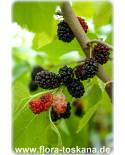Morus nigra - Black Mulberry
BESTSELLER (rank 13) - With its small size and deep black, blackberry like, sweet-juicy berries, the Black Mulberry (Morus nigra) is the most popular among the mulberry trees. Harvesting begins in our plants propagated from cuttings already in the year of planting.
Many of you may still remember mulberry trees in your (grand)parents' garden, because just 60 years ago they were as common in gardens as quince and pear trees. After the Second World War, the robust fruit shrubs with their multiform, wavy, rough leaves gradually disappeared and were soon forgotten. But now they are being rediscovered, because the robust, uncomplicated, pest-free trees easily tolerate the cold of average winters in the garden. The yellow flowers appear in May and June and look like willow catkins. Only 6 to 8 weeks later they are followed by ripe, black fruits. The flowers are separated into male and female catkins that open at the same time. The female flowers are pollinated by wind, thus only one plant is necessary for a rich harvest every year. The harvest lasts for weeks, during which the small delicacies are best snacked fresh from the tree. They look very similar to blackberries, but taste sweet and fruity without a tart aftertaste. Secret snacking is almost impossible: black mulberries leave distinct traces of color on the fingers and tongue, which, however, can be easily washed off. The Black Mulberry is the smallest of three mulberry sisters (Morus alba, Morus rubra) and also has the smallest leaves. It reaches a size of 6m on average and therefore fits into any front yard or orchard, especially since it is easy to keep the naturally well-branched crown in shape by regular trimming in March. Alternatively, you can keep black mulberries for many years in a container with a long outdoor season from March to November. They lose their leaves in the fall and can then be overwintered very easily in an unheated, low-light place (garage, summer house, small greenhouse, barn, warehouse, etc.).
![]() Quality: tasty fruits from your own crop; long harvest time; attractive leaves; robust & easy to care for; hardy when planted in the garden; easy to winter as container plant
Quality: tasty fruits from your own crop; long harvest time; attractive leaves; robust & easy to care for; hardy when planted in the garden; easy to winter as container plant![]() Use: planted in the garden; in pots starting from March/ April to October/November outside on balcony, terrace or in the garden – during winter in a room; all year round in an unheated conservatory
Use: planted in the garden; in pots starting from March/ April to October/November outside on balcony, terrace or in the garden – during winter in a room; all year round in an unheated conservatory
Data sheet
- Family
- Moraceae
- Origin
- Asia (mediterranean)
- Flowering period
- Spring
- Color of flowers
- Yellow
- Fruits
- Edible fruits
- Growth
- Tree
- Location
- Sunny
- winter temperature
- Hardy
- Minimum temperature
- -20 °C
- Hardiness Zones
- 6
- Height
- mehr als 5 m
You might also like
Customers who bought this product also bought:






































































